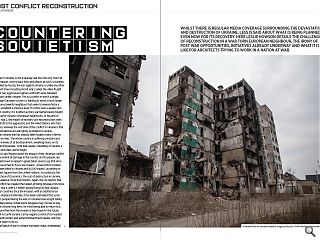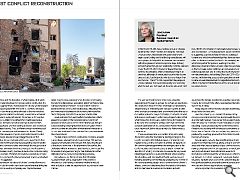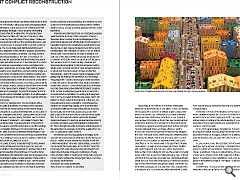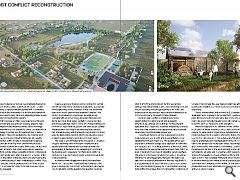Post Conflict Reconstruction
11 Oct 2023
Whilst there is regular media coverage surrounding the devastation and destruction of Ukraine, less is said about what is being planned even now for its recovery. Here Leslie Howson details the challenges of reconstruction in a war torn European neighbour, the irony of post war opportunities, initiatives already underway and what it is like for architects trying to work in a nation at war.
The war in Ukraine, is not a faraway war but one very much at the European Union’s back door and affects all NATO countries. Instigated by Russia, the war against Ukraine, is unlike any other of recent times including World War 2 when the Allies fought against two aggressive regimes until both were defeated, a scenario unlike Ukraine. This is a conflict in which a single sovereign European country is fighting to resist a much larger and more powerful neighbour that seeks to reverse history and re-establish a previous level of control over a weaker and smaller country. It is in effect a proxy war being bravely fought on behalf of Ukraine`s European neighbours. At the end of World War 2, the means of recovery and reconstruction were given both to the aggressors and the Allied nations who had suffered, whereas the outcome of the conflict in Ukraine is that any international aid will rightly, be limited to Ukraine. The Ukraine war has already been hugely costly in terms of human lives.
The whole country is suffering constant and extreme levels of air bombardment, wreaking havoc on its cities and its people. Until that ceases, rebuilding of Ukraine`s towns and cities cannot begin. Facts and figures about the impact of the Ukrainian conflict and the extent of damage to the country and its people, are too well known to repeat in great detail, save to say that since Russia launched its full-scale invasion , at least 9500 civilians have been killed in Ukraine and 16,000 injured , according to the latest figures from the United Nations.
According to the Kyiv School of Economics, the cost of destruction in Ukraine, is calculated at more than $143bn. Again, the UN reports that this conflict has created the fastest-growing refugee crisis since World War II, with 6.3 million people forced to flee Ukraine to other countries since the invasion, with an additional six million displaced internally. It has been estimated that some 23,000 people fleeing the war on Ukraine have sought safety in Scotland alone. Whilst some refugees may choose to stay outside Ukraine long term, for most being able to return to a homeland free from the invader is their hope for the future, though not until Ukraine`s army regains control of its invaded lands and borders and aerial bombardment ceases, will it be safe for them to do so. The fallout of war in Ukraine has been chaos, widespread destruction, and the desolation of whole regions, all of which leaves challenging issues for recovery and re construction. It is being suggested that a Marshall plan for Ukraine will be required like that put in place after World War 2. However, that was a recovery plan for all countries affected by the war including two aggressor nations and following a clear peace settlement. Such a plan is surely not relevant for Ukraine, as the eventual outcome is unlikely to be defeat of an invading aggressive nation i.e., Russia but about recovering Ukraine’s borders, stopping attacks, and then starting to recover and reconstruct this invaded country. Thus, a different though nonetheless still complex, recovery plan will be required in Ukraine.
Though without the assurance of peace, post conflict reconstruction cannot begin, pre planning a strategy for post conflict reconstruction can start even prior to any cease fire. It is then that decisions will have to be made regarding what to rebuild of Ukraine`s towns and cities, even though the very purpose of some may have been almost lost, Mariupol, once the centre of Ukraine’s steel industry, bombed to destruction by Russia, being a prime example. Thankfully the country`s capital Kiev remains intact, its iconic Saint Sophia Cathedral seeming to stand defiant against the aggressor. Rebuilding on the rubble of Ukraine`s bombed towns and cities will take time with many technical and logistical difficulties to overcome. Building completely new may be the easier option in some areas, especially when it comes to re housing the returning dispossessed population, restoring infrastructure, building hospitals and schools. Recovery will of course be about more than construction but also about rebuilding lives and memories and addressing the human suffering and the devastating long-term effects on people`s mental state.
Good outcomes from post conflict reconstruction efforts appear to be reliant on the Ukrainians being in control of whatever recovery and re construction initiatives are brought to bear, including ensuring that there is no corruption when it comes to control and allocation of international financial aid a process which will need to be controlled from presidential level down to local level. The task of post conflict re construction in Ukraine, presents many unique challenges but also opportunities. This war, has created a humanitarian crisis not seen in Europe since the end of the second world war. In the aftermath of the conflict, the challenges will be immense, not least how to accommodate the thousands of refugees returning to their shattered and often obliterated homes, many risking returning even now. Ironically, post conflict re construction will require re-establishment and re-organization of the country’s infrastructure and making of decisions whether to rebuild, what to build or to take the opportunity to reconstruct in a new manner. The war has forced Ukraine to find ways around its dependence on Russian oil and gas. So perhaps an opportunity for Ukrainians to move from the current high car dependency, despite having an extensive public transport system, to cities which are less car orientated and grow inward rather than up or out, with bicycle paths, alleys, footbridges, courtyards, arcades, and riverside esplanades. Another irony of opportunities is that whilst Russia tries to conquer a nation it once dominated, it is at the same time erasing the vestiges of its own control; the complete destruction of the Azovstal Steel Plant in Mariupol once the pride of Stalin’s industrial might, by Putin’s forces, is one example.
There would appear to be a number of key aims going forward. Ensuring that international funding coming into the country is properly distributed and goes to where it is most needed is one, avoiding corruption is another. All depends on the current legitimate government remaining in place as the conflict recedes and that civil society is able to monitor the allocation of funding. Another aim is to ensure that any house rebuilding programme is quick and efficient, whilst avoiding the shoddiness and poor quality of Soviet era housing and including rebuilding communities devastated by war. Control of the national planning, design, and re-construction of Ukraine`s villages, towns and cities should be in the hands of Ukrainians and not international investors and outsiders, and with assurances that foreign investment & expertise converging on Ukraine, do not result in the often-inappropriate international style of city-building. Finally, all post conflict recovery decisions made today should be for the long term. Since the February 2022 invasion of Ukraine, many recovery proposals and plans have been brought forward at an international level. These range from a supportive plan from Lithuania one of Ukraine`s Baltic state allies, to a report rebuilding Ukraine produced by the Centre for Economic Research, to a solidarity with Ukraine policy document by the Architects Council of Europe, and recovery proposal plan produced by a working group within the National Council for the Recovery of Ukraine. Several papers have also been published by eminent academics on the impact of war, giving advice on economic, social and other practical aspects of post conflict recovery making comparisons with other supposedly similar situations and giving advice and observations from experts on international conflict around the world. However, whilst much can be learnt from other natural and man-made disaster situations, inevitably every post conflict and post disaster will have particular political, social and economic consequences which as with Ukraine require tailored responses. Ukraine`s planners too are keen to play a key role in the forward planning of their country`s post conflict recovery, to improve their status within Ukraine and to ally themselves to town planning organizations across Europe. Janet Askew. President of the European Council for Spatial Planners, has provided Urban Realm with information on the efforts of European Council for Spatial Planners ECTP-CEU, in support of Ukrainian Planners and of discussions they have had on the recovery process.
The ECTP-CEU, is an umbrella organization which a new association of planners in Ukraine could join. However, the planners of Ukraine have first had to set up their own association within the National Union of Architects of Ukraine (NSAU). The planner’s section, called the Association of Spatial Planners (ASP), has the backing of NSAU. Apart from seeking to ensure-quality services in the field of urban planning, the ASP`s stated aims are to combine the efforts of professionals from various fields, including architecture and urban development, spatial planning, and urban studies, to create conditions for effective and sustainable development of territories within Ukraine and to play a role in promoting international cooperation for the country`s recovery and re construction. NSAU itself held a special conference early in 2023, in Warsaw, to develop these objectives, including the stimulation of economic growth and development of individual regions and improving the socio-economic situation in Ukraine in general. It is widely acknowledged, that the rebuilding of Ukraine must enshrine principles of sustainability whilst accepting that speed will be of the essence due to the need to restore homes and workplaces as quickly as possible. With 70% of Ukraine`s population living in towns and cities, much attention is already turning to reconstruction initiatives in centres of urban living. Reuters recently reported proposals being discussed for the complete transformation of six war-hit towns badly damaged in Russia’s full-scale invasion under a reconstruction programme announced by Prime Minister Denys Shmyhal.
Kyiv’s Western partners are preparing to pour billions of dollars into Ukraine to support reconstruction efforts after 14 months of war. It is said that the towns of Borodianka and Moshchun near the capital Kyiv, Yahidine in the north, Trostianets and Tsyrkuny in the east, and Posad-Pokrovske in the south, would be rebuilt comprehensively and according to new principles under an experimental programme and to fast-track reconstruction even though the war is not over. Another initiative has been in Kyiv where seemingly only a few weeks after Russian forces had pulled out of the suburb of Irpin, leaving a trail of unburied bodies, blasted homes, and booby-trapped rubble, 120 architects from all over Ukraine, were summoned to discuss what to rebuild first and how to do it with the two competing priorities at issue seen as repairing and replacing what had been damaged and how to make Ukrainian cities better than they were. Amongst the gathering group in Kyiv, was a team from Archimatika, a Kyiv firm of architects and urban designers, the largest in Ukraine. Of course, international advice moral support, conferences and proposed planning initiatives is one thing, but kick- starting workable initiatives to deal with the realities on the ground is quite another.
Apparently, it was with this in mind that Archimatika designed Comfort Town city, a new district in Kyiv comprising new housing which screams of yellows, bright oranges, lime greens and pastel blues, rising eight stories high, extending over 46 hectares and housing more than 20,000 people. It was designed to brighten up the former grey Soviet buildings of the 1950s and 60s. It’s no accident that the colourful town resembles a Legoland as seemingly project architects Dmytro Vasyliev, Aleksandr Popov, and Olga Alfiorova, had the thumb-size construction toys front of mind as they designed the town. Their goal was to create a beautiful residential block that would be sellable, even in a time of crisis. Life in Comfort Town as the name suggests is easy living with cafes, stores and offices sit on the bottom level of the apartment complex and residents, includes a retail complex and fitness facilities with swimming pools. Kyiv has had a rather grey housing history when in 1954 Nikita Khrushchev, the Soviet Communist leader at the time, to ease the national housing crisis , ordered architects to focus entirely on unadorned, standardised builds and at low-cost. Thus, tens of thousands of identical colourless apartments were erected throughout Ukraine. While they did serve their social purpose on a basic level, their drab aesthetic is an eyesore, and many have since been demolished. Comfort Town was an obvious contrast to that drab and austere model of mass housing. Otherwise, the work of Archimatika, is very much about what is required to restore the country and the life for its people to some sort of normality post conflict and importantly with emphasis on retaining the cultural identity of Ukraine.
Examples of their projects particularly significant for the country’s recovery include:- POCHATOK (appropriately translated as `the beginning) : is a unique affordable housing design model that Archimatika propose be rolled out throughout Ukraine, in an attempt to solve the housing crisis , an issue even before the current conflict.
POSAD POKROVSKE, the re construction of a Village destroyed by the invader: According to Oleksandr Stolovyi, research partner with Archimatika , the phenomenon of `the village `is significant in the rural cultural history of Ukraine, and a factor which is fundamental to the approach to this project design. The project involves rebuilding in such a way as to preserve the authentic image of `the village` by introducing a design code.
LYCEUM No.2: A school for 400 children to be rebuilt after being destroyed during the fight for Hostomel. Seemingly this project is being carried out by a charitable foundation as part of what is called `schools of the future ` project. According to Mykola Morozov, partner with Archimatika, this will allow the development of an effective framework for the successful restoration and rebuilding of educational institutions throughout the country. `
Whilst Ukrainian architects and planners continue to work on both pre-war and new recovery projects, help is coming from outside professionals, albeit seemingly often irksome and controversial for some, because of how this is being organized and the apparent lack of public consultation. This perhaps illustrates the importance of major re-construction initiatives being led by capable professionals within Ukraine to ensure that the people of Ukraine get what they want and not what outside professionals however employed, think is best. Whilst most Ukrainian architects and others will no doubt welcome input from outside fellow sympathetic fellow professionals, they might prefer such help to be given in a manner which respects the wishes of the Ukrainians and after having the fullest understanding of what is needed post conflict. Thus, whilst specialist outside professionals contribute to post conflict re construction, their remit and roles need to be carefully managed. Clearly, a recovery strategy and re construction cannot commence in earnest until peace is established, appropriate forward planning for the aftermath of war can and should begin now though planned and organised carefully. Post conflict re construction is first about re-establishing normality with an early strategy to restore the basics for day to day living, food, water, sanitation, energy supplies and once established, then to follow with home building and provision of health and educations and other social facilities. Infrastructure is next thus re-establishing basic services, then master planning with frameworks within which to build. Early decisions will be needed whether to rebuild as was or to take the opportunity to reconstruct in new manner.
The issue of accommodating the thousands of Ukrainian refugees returning home will require varying levels of support especially housing with community rebuilding and enabling at the heart of any rebuilding programme in the housing sector especially. For them, post conflict re construction is as much about repairing memories as about physical building. In Ukraine whole villages towns and cities have been wiped from the map with many buildings flattened to the ground leaving only their almost archaeological like imprint. How to rebuild is not the question; the question becomes what is left of the city to rebuild. Setting up planning damage monitoring research units nationwide might be one way of assessing and damage auditing to be better able to prioritize the recovery and reconstruction relative to the country’s economy, transport infrastructure etc. Ironically, post conflict re construction creates opportunities to re structure not just as regards infrastructure, services, and buildings but industry and agriculture thus a country`s economy and possibly a chance to re direct that economy, even advancing nations beyond where they might have been without war.
A significant factor in Ukraine`s governance is in the mayoral system, and it is this which seems likely to drive development of each major city. This system allows each city to be automatous as regards its approach to how cities are managed, and this is likely to extend to their post conflict reconstruction as well as the regions around them. With the level of destruction and task of rebuilding varying perhaps this system is most appropriate to the needs of Ukraine at this time, the advantage being that each city region can deal with the scale of devastation in the way they think fit and appropriately. Although Ukraine is such a vast country and a national planning policy for re construction seeming to be difficult to achieve, the coming together conference of Ukraine`s Mayors later this year does provide hope with the potential to establish a common approach to reconstruction city to city. Clearly, international funding from the EU, surrounding allies and the US, is going to be a major factor controlling the pace, timing and extent of reconstruction city by city, and region by region but will probably come with certain caveats to control, such as the security of its allocation.
Whatever happens in the aftermath of the conflict in Ukraine, the future reconstruction of that country will require the same level of organization, determination, and resilience shown by its people in attempting to free their country from the tyranny of their adversaries. Rebuilding will require appropriate and ongoing support of the US, U.K. and other allies probably for many years ahead. Restoring peace and recovery effectively requires international co-operation, by democratic nations of the world working as one, with self-interests set aside and in a manner which respects the wishes of the people who have suffered conflict and the destruction of their sovereign homeland. What would seem in the best interests for Ukraine is that all outside support be assimilated and coordinated from within Ukraine and from presidential level down, otherwise the chaos of war could end up as chaos in peace.
|
|







